Japanese Maple Wood
- September 7, 2023
- 0 comment

Japanese Maple Wood, scientifically known as Acer palmatum, is an extraordinary hardwood originating from the far-eastern regions of Asia. It has garnered widespread acclaim for its stunning aesthetic, exceptional versatility, and distinctive attributes, solidifying its esteemed status within the realm of woodworking and craftsmanship. This wood species embodies a remarkable blend of elegance and functionality, offering a myriad of applications that cater to diverse artistic and practical endeavors. Its rich history and enduring popularity make Japanese Maple Wood a captivating subject of exploration, showcasing the enduring allure of nature’s finest creations.
Texture
Japanese Maple Wood boasts an exceptional and finely-textured grain pattern that is nothing short of luxurious. This unique wood species exhibits a remarkable combination of straight and occasionally wavy or curly grain, creating a visual feast for woodworkers and artisans. The fine texture of Japanese Maple Wood not only adds to its aesthetic appeal but also enhances its workability. Craftsmen appreciate the ease with which it can be shaped, carved, and polished to achieve intricate designs and smooth finishes. This feature makes it a cherished material for creating exquisite woodworking projects, whether it’s the delicate details on a cabinet or the graceful curves of a custom-made piece of furniture.

Bark
The bark of the Japanese Maple tree presents a subtle yet distinctive charm. Its surface is notably smooth, adorned with a grayish-brown hue that complements the wood’s natural beauty. While not the primary focus of woodworking or craftsmanship, this unique bark has found its place in traditional Japanese crafts, where it has been used in basketry and occasionally as a source of natural dyes. It may not be as celebrated as the wood it protects, but it still carries a touch of the Japanese Maple’s elegance and understated grace.
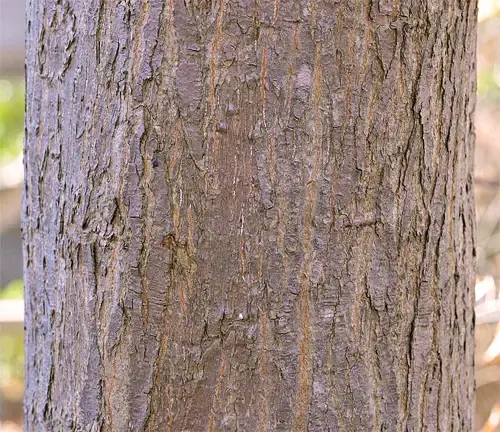
Furniture
Japanese Maple Wood has long held its position as a favored choice for crafting exquisite and enduring furniture. Its rich, warm colors ranging from reddish-brown to delicate pinkish hues give it a unique character that is hard to match. Craftsmen and designers appreciate the wood’s inherent stability and workability, which ensures that furniture made from Japanese Maple not only looks stunning but also stands the test of time. Whether it’s crafting intricate cabinets, graceful tables, or chairs with a touch of elegance, Japanese Maple Wood lends an unmistakable air of sophistication to interior spaces, making it a cherished material among those who value both form and function.

Weapon
Throughout history, Japanese Maple Wood has played a role in crafting various weapons, serving as the sturdy shafts of spears and the handles of swords. Its durability and strength made it a preferred choice for these applications, adding both practicality and a touch of artistry to these essential tools of warfare.
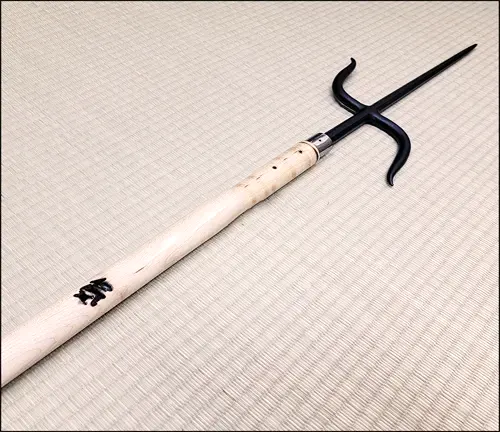
Firewood
While Japanese Maple Wood is primarily valued for its aesthetic and functional properties, it can be burned for heat if needed. However, given its status as a hardwood and its limited availability, it is not the most common choice for firewood. Its true value lies in its versatility and beauty, which extend well beyond the confines of a fireplace.

Construction
Japanese Maple Wood has a rich history of use in traditional Japanese architecture. Its structural stability and resistance to decay have made it a preferred choice for various interior and exterior applications in historic buildings, temples, and other architectural wonders. Its enduring presence in these structures stands as a testament to its strength and reliability.

Plywood and Board
Japanese Maple Wood occasionally finds its way into the production of high-end plywood and boards. These panels often feature a thin veneer of Japanese Maple on the surface, providing an elegant finish for interior design projects, cabinetry, and other applications where a touch of sophistication is desired.
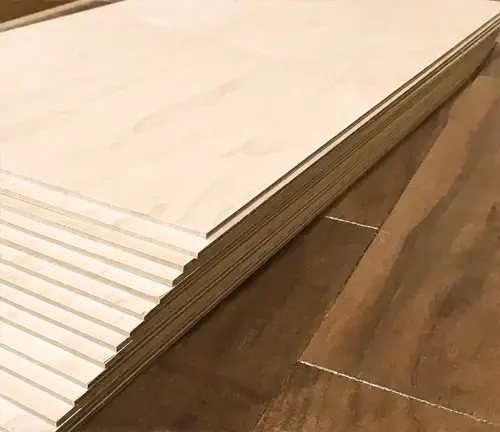

Railroad Cross Ties
Japanese Maple Wood was once a preferred choice for railroad crossties, owing to its robustness and resilience. Its ability to withstand the heavy loads and constant wear and tear of the railroad industry made it a reliable option. However, as times evolved, modern alternatives with more widespread availability and cost-effectiveness gradually supplanted Japanese Maple Wood in this application. Consequently, the decline in its use for railroad cross ties has allowed this exquisite wood to be conserved for more specialized and artistic purposes, emphasizing its enduring value beyond the realm of transportation infrastructure.
Pallets
Pallets, the unsung heroes of logistics and warehousing, serve as the sturdy backbone of countless supply chains worldwide, and while they are often constructed from utilitarian woods, Japanese Maple Wood presents an intriguing alternative. Renowned for its strength and durability, Japanese Maple could be harnessed to create pallets that not only withstand the rigors of heavy loads but also introduce a touch of elegance into the industrial landscape. By using Japanese Maple Wood for pallets, we elevate this essential workhorse into an aesthetically pleasing and durable component of modern logistics, bridging the gap between functionality and style in the world of shipping and storage.
Cants
Cants, the rectangular wooden blocks typically created during the initial stages of lumber processing, offer a unique opportunity for Japanese Maple Wood to shine. These rough-hewn pieces are often overlooked, yet they play a crucial role in the transformation of raw logs into refined lumber. Japanese Maple cants, with their fine texture and unique grain patterns, can elevate the lumber milling process, ensuring that even the early stages of wood preparation are carried out with precision and care. By infusing cants with the beauty of Japanese Maple, we not only enhance the quality of the final lumber but also pay homage to the tree’s inherent grace and strength.
Fencing
Fencing serves as the boundary between the outside world and our private spaces, and Japanese Maple Wood can transform this utilitarian necessity into a work of art. When used in fencing, Japanese Maple imparts an air of elegance and natural beauty to landscapes. Its fine texture and warm, rich colors make it an ideal choice for creating fencing that not only provides security and privacy but also enhances the overall aesthetics of a property. Japanese Maple Wood fencing can turn an ordinary garden or backyard into a serene and picturesque retreat, where the boundary between nature and human design becomes a seamless blend of artistry and functionality.

Wooden Crates
Wooden crates, often overlooked but essential for shipping and storage, can be elevated to a new level of sophistication with the use of Japanese Maple Wood. These crates not only protect their contents but also make a statement about the value and care placed on the items they encase. Japanese Maple Wooden crates, with their distinctive grain patterns and rich colors, provide an elegant solution for packaging and storing delicate or high-end products. They demonstrate a commitment to quality and aesthetics, ensuring that the act of unboxing becomes a memorable experience, reflecting the enduring allure of Japanese Maple in every detail.

Wood Decking
A deck is more than just an outdoor space; it’s an extension of one’s home and lifestyle. Japanese Maple Wood decking transforms this extension into a sanctuary of natural beauty and sophistication. With its fine grain, warm hues, and durability, Japanese Maple enhances the outdoor experience, creating a space that invites relaxation and contemplation. Its unique blend of strength and aesthetics makes it a choice that transcends practicality, turning a deck into a statement of personal style and a testament to the enduring beauty of nature.
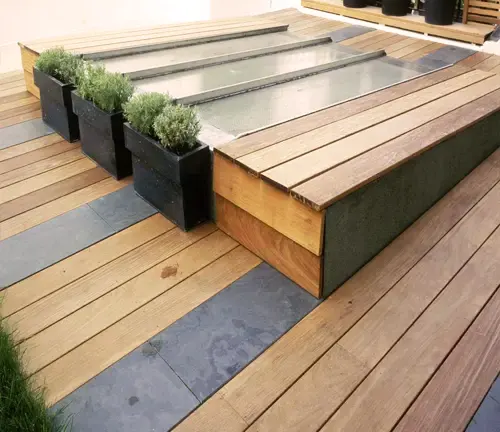
Shiplap
Shiplap, a classic and enduring interior wall covering, takes on a new dimension of elegance when crafted from Japanese Maple Wood. This traditional design element, characterized by its overlapping boards, gains a touch of refinement and sophistication with the fine texture and vibrant colors of Japanese Maple. In homes and commercial spaces alike, Japanese Maple Shiplap creates a backdrop that not only enhances architectural details but also infuses the environment with warmth and character. It stands as a testament to the enduring appeal of this remarkable wood species, reminding us that even the most utilitarian of design elements can become works of art when crafted from the finest materials.

Live Edge Siding
Live Edge Siding, often crafted from the illustrious Japanese Maple Wood, represents a harmonious fusion of nature and design. This captivating siding style retains the organic, irregular edge of the wood, celebrating the tree’s unique growth patterns and preserving its natural beauty. As the siding adorns homes and structures, it not only provides insulation and protection but also brings a touch of rustic elegance and timeless charm. The live edge detailing, with its unpredictable contours, imparts an unparalleled sense of authenticity and character to any architectural design. Each piece of live edge siding tells a story, showcasing the journey of the tree and honoring its enduring legacy as part of a living ecosystem.
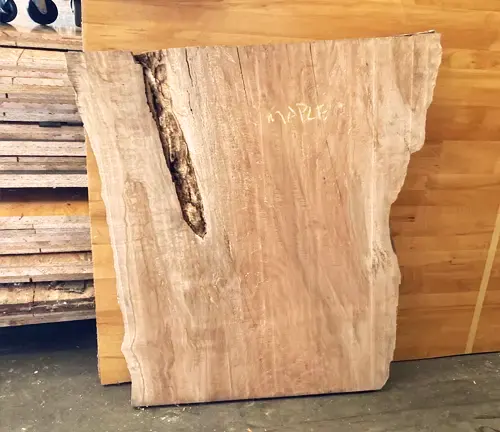
Slabs
Japanese Maple Wood slabs are artistic marvels in their own right. These broad, flat sections of wood, often featuring the distinctive live edge, offer a canvas for creativity and craftsmanship. When meticulously crafted into furniture, countertops, or decorative pieces, Japanese Maple Wood slabs become focal points within interior spaces, blending natural aesthetics with functional elegance. The intricate grain patterns and vibrant hues inherent to Japanese Maple lend these slabs an unmatched visual appeal, making them cherished by woodworkers and designers alike. Whether as a dining table that invites conversation or a coffee table that sparks admiration, Japanese Maple Wood slabs infuse living spaces with a touch of the sublime.
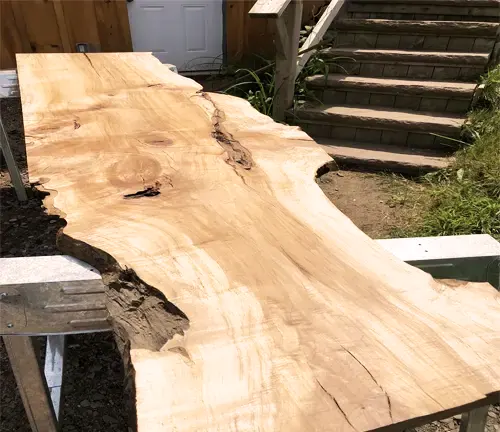
Beams
Japanese Maple Wood beams, with their exceptional strength and captivating beauty, have played a significant role in both traditional and contemporary architecture. These sturdy structural elements not only provide essential support but also elevate the aesthetic qualities of a space. When employed in interior design, Japanese Maple beams imbue a sense of warmth and sophistication. Their fine grain and rich coloration add a timeless elegance to ceilings and other architectural features. Beyond their practical function, these beams carry the enduring spirit of the tree they were sourced from, connecting the built environment to the natural world, and reminding us of the profound beauty that lies within Japanese Maple Wood’s enduring embrace.

FAQs
- What makes Japanese Maple Wood unique for woodworking and craftsmanship?
Japanese Maple Wood is renowned for its fine texture, exceptional grain patterns, and rich coloration, making it a favorite among artisans. Its versatility and workability allow for intricate carving and detailed craftsmanship, setting it apart as a top choice for those who value both form and function in their creations. - Can Japanese Maple Wood be used for outdoor applications like wood decking and fencing?
Yes, Japanese Maple Wood can be used for outdoor projects like wood decking and fencing. However, proper maintenance is crucial to preserve its beauty when exposed to the elements. It’s often chosen for these applications when aesthetics are a top priority. - How does Japanese Maple Wood contribute to the shipping and storage industry?
Japanese Maple Wood can elevate the quality and appearance of pallets and wooden crates, providing a more aesthetically pleasing and durable solution for shipping and storage needs. This not only protects the contents but also reflects a commitment to quality in packaging. - What is the significance of live edge siding and slabs made from Japanese Maple Wood?
Live edge siding and slabs celebrate the natural contours and beauty of the wood, adding a touch of rustic elegance to architectural and interior design projects. Each piece tells a story of the tree’s growth and provides a unique focal point in living spaces. - How can Japanese Maple Wood be used in structural elements like beams?
Japanese Maple Wood beams, known for their strength and aesthetics, can enhance both traditional and modern architecture. They not only provide structural support but also bring warmth and sophistication to ceilings and other architectural features. - Is Japanese Maple Wood suitable for DIY projects and home improvements?
Yes, Japanese Maple Wood can be used in DIY projects and home improvements, but it’s essential to have the right tools and skills due to its fine texture. It can be an excellent choice for creating custom furniture, cabinets, and decorative elements that add a touch of luxury to your living spaces.
As we wrap up our exploration of Japanese Maple Wood, we’ve ventured into the world of a wood with a rich cultural and aesthetic heritage. Its exquisite range of colors, delicate grain patterns, and iconic foliage have left an indelible impression. Whether you’re crafting with it or appreciating its ornamental presence in gardens, Japanese Maple Wood embodies elegance and artistic inspiration. If you have any questions or would like to share your experiences with Japanese Maple Wood, please don’t hesitate to reach out. Until next time, may your creative pursuits be as intricate and captivating as the Japanese Maple itself.














Leave your comment